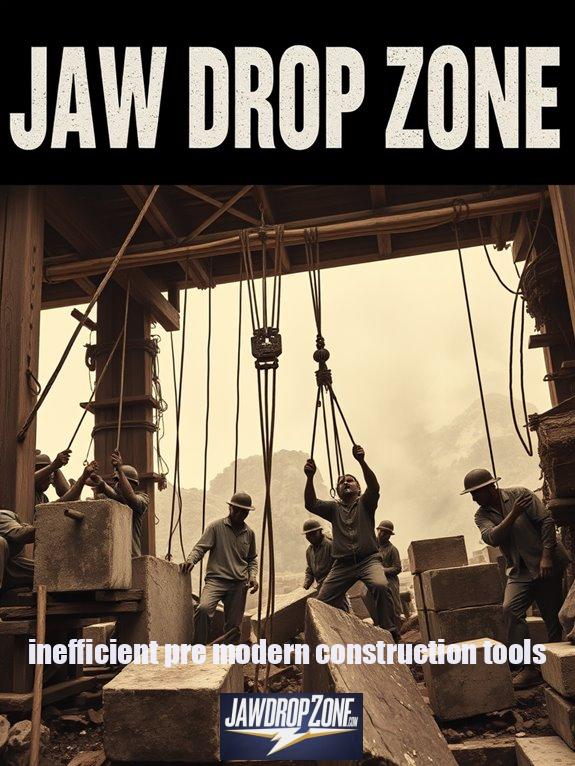Creating Christ the Redeemer wasn’t just a walk in the park—more like a climb up a steep mountain! Imagine this: workers battling slippery slopes and dangerous weather at 700 meters above sea level. And let’s not forget the engineering nightmare of transporting statue pieces from France, like Christ’s head in 50 parts! This monumental endeavor was a Tetris game played with enormous blocks. Curious about how they all pulled it off? Stick around; you might be amazed!
Quick Takeaways
- A small cogwheel train was essential for transporting massive statue components up steep slopes, resembling a complex logistics puzzle.
- Slippery weather and high altitude created hazardous working conditions, increasing the risk of accidents for construction crews.
- The project’s financing relied on grassroots fundraising, demonstrating strong community support for the large religious monument.
- Engineering issues included transporting Christ’s head in 50 pieces from France and ensuring the statue could withstand winds up to 250 km/h.
- Final design debates included choosing between different aesthetic tiles, ultimately using durable materials like reinforced concrete and soapstone tiles.
The Unseen Hurdles of Christ the Redeemer’s Creation

When you think about building a massive statue perched atop a mountain, the first thing that probably comes to mind is the grand vision, right? You know, the kind of vision that makes you feel like you’ve conquered the world just by envisioning it. But let’s talk about the real challenges lurking behind that impressive visage of Christ the Redeemer atop Mount Corcovado.
Picture this: a towering statue, 30 meters high and standing proudly at 700 meters above sea level. Now, getting materials up to that altitude isn’t as simple as a casual hike. You need a small cogwheel train—once used for tourists—to lug everything up those steep, unforgiving slopes. It’s almost like playing a game of Tetris, only the blocks are enormous and potentially deadly.
Transporting materials to build a 30-meter statue at 700 meters above sea level feels like a real-life Tetris nightmare!
And speaking of deadly, let’s not forget the weather conditions. You might think you’d don layers and brave the elements, but construction workers faced not just slippery slopes, but riskier situations too. Can you envision hanging off scaffolding high up while rain pours down? It’s a miracle we didn’t lose anyone to a slip with all that strife.
Now, while construction might seem like an over-the-top thrill ride, funding a project like this isn’t exactly a walk in the park either. The entire cost, around $250,000 back in the day, sounds like chump change now, reflecting about $4.8 million in today’s terms.
But can you believe the Catholic community—the real champions of this endeavor—managed to finance it all through community fundraising? They gathered support, showing that sometimes even the mightiest of visions hinge on grassroots efforts.
In fact, the entire surface of the statue was eventually covered with approximately 6 million soapstone tiles, reflecting both the dedication of the community and the project’s ambitious scope.
But it wasn’t just about throwing money at the statue. Local economies felt a boost throughout the project’s nine-year timeline, which is quite a commitment for a group of folks just trying to guarantee Jesus has the best view in Rio.
And then, we plunge into the design territory. Early sketches made Christ seem quite indecisive—should He hold a cross or a globe? In the end, open arms to embrace the city turned out to be the ultimate choice! What a clever nod to peace and protection.
Designers really outdid themselves by utilizing innovative materials like reinforced concrete and weather-resistant soapstone tiles. I can’t fathom the meetings, filled with heated debates over how glossy those tiles should be!
All of this combines into the cultural implications wrapped around this statue, which has become more than just concrete; it’s an emblem of faith and identity, reigniting spiritual fervor. I mean, who wouldn’t want to say they’ve gazed up at a modern wonder of the world?
Engineering Hurdles During Construction

Building a monumental statue like Christ the Redeemer comes with its fair share of engineering hurdles that’d make even the most seasoned architect sweat.
Just envision the logistical nightmares! Here’s what the engineers faced:
- Location: Perched 700 meters above sea level on Corcovado Mountain, access was a nightmare.
- Materials: Transporting huge parts from France, including Christ’s head in 50 pieces? Yikes!
- Wind Resistance: Brace yourselves! It had to withstand winds of up to 250 km/h.
- Foundation: A tiny 15-meter base for something so grand? Talk about a balancing act!
With these hurdles, my inspiration for creating the Jaw Drop Zone website sparked.
I wanted to explore feats that make us gasp, and Christ the Redeemer is a perfect example! Just like the first woman to conquer Everest, the engineers had to use remarkable ingenuity to overcome these extraordinary obstacles!
How could they conquer such challenges? The brilliance of engineering truly shines here, doesn’t it?
References
- https://www.thecollector.com/how-was-christ-the-redeemer-built/
- https://strawberrytours.com/the-story-behind-rio-s-christ-the-redeemer-statue
- https://aleteia.org/2021/11/24/the-conversion-of-an-engineer-during-the-construction-of-rios-christ-the-redeemer
- https://study.com/academy/lesson/why-is-christ-the-redeemer-considered-one-of-the-seven-wonders-of-the-world.html
- https://ohmyfacts.com/religion-history/20-facts-about-christ-the-redeemer/
- https://www.thecollector.com/why-was-the-statue-of-christ-the-redeemer-built/
- https://en.clickpetroleoegas.com.br/construcao-do-cristo-redentor-o-monumento-erguido-no-alto-do-corcovado-nao-so-representa-a-fe-brasileira-mas-tambem-e-um-marco-da-engenharia-brasileira/
- https://archive.org/download/renewingidentityandmissionocropt/RenewingIdentityAndMissionOCRopt_djvu.txt
- https://streetartutopia.com/2024/05/20/christ-the-redeemer-an-icon-of-faith-and-artistry/






